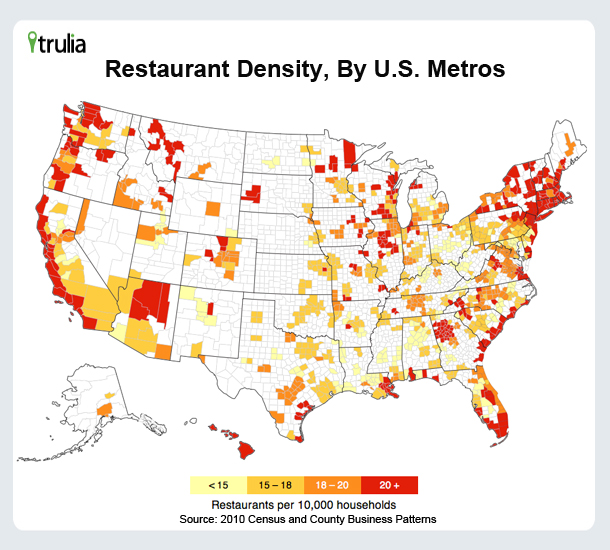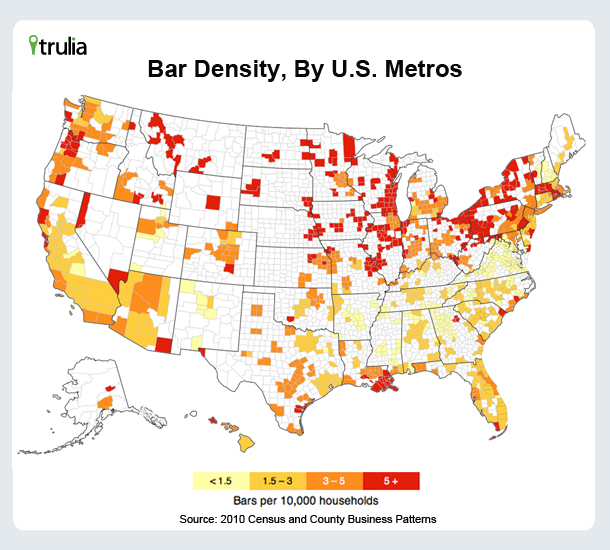What are you doing tonight? Will you and your friends be going out to eat or meeting for a drink? Like everything else, where you hang out depends on where you live. Using Census data, we found the metros with the highest density of restaurants and bars, adjusting for the number of households (details at end of post). We didn’t try to measure quality since that’s a matter of personal taste, and the best-restaurant or favorite-bar debate can get fierce. Instead, we focused on the quantity of restaurants and bars that locals can choose from. Look at the top 10 lists below: some places are eating towns, and others are drinking towns, but few are both.
Eating Towns
San Francisco has the most restaurants of all large metros in the U.S., adjusted for the number of households. No other major metro comes close: at 39.3 per 10,000 households, San Francisco has nearly 50% more restaurants relative to its size than #2 Fairfield County, CT (the southwest corner of the state nearest New York City). All of the top eating towns are on or near the ocean. If you want lots of restaurants to choose from, move toward the coasts.
| Top Metros for Eating Out | |||
| # | U.S. Metro | Restaurants per 10,000 households | Median price per sqft of for-sale homes |
| 1 | San Francisco, CA | 39.3 | $459 |
| 2 | Fairfield County, CT | 27.6 | $222 |
| 3 | Long Island, NY | 26.5 | $217 |
| 4 | New York, NY-NJ | 25.3 | $275 |
| 5 | Seattle, WA | 24.9 | $150 |
| 6 | San Jose, CA | 24.8 | $319 |
| 7 | Orange County, CA | 24.8 | $260 |
| 8 | Providence, RI-MA | 24.3 | $146 |
| 9 | Boston, MA | 24.2 | $219 |
| 10 | Portland, OR-WA | 24.0 | $129 |
Note: among the 100 largest metros.
Living in a great eating town isn’t cheap: homes for sale in seven of the top 10 eating towns have a median price per square foot of $200 or more. Why are eating towns more expensive? Many people are willing to pay more to live near restaurants. But, more importantly, high-income people have more money to spend on eating out, so the high-cost places where high-income people tend to live can support more restaurants.
Three of the top eating towns are somewhat more affordable, with home prices averaging less than $200 per square foot: Seattle, Providence RI and Portland OR. Each has a thriving and innovative local food scene. Lots of young chefs choose these smaller cities because it’s cheaper to start up restaurants there than in more expensive markets like San Francisco and New York. And it doesn’t hurt that Providence is the home of Johnson & Wales University, a well-known cooking school.
Beyond the largest 100 metros, small vacation towns often have lots of restaurants relative to their size because they cater to a large tourist or seasonal population. Ocean City NJ, Cape Cod MA and Myrtle Beach SC all have even more restaurants, relative to their size, than San Francisco.
Looking across large and small metros, the map shows that America’s eating towns are on the coasts. Most metros up and down the coasts — from Miami to Boston and from Seattle to San Diego – have at least 20 restaurants per 10,000 households. Most inland metros have fewer — or much fewer — than that.
Drinking Towns
Where do people go out to drink their calories instead? The top drinking towns – based on the number of bars adjusted for the number of households – is a totally different list than the top eating towns. New Orleans tops the list, followed by six Midwest (Milwaukee and Toledo) or near-Midwest (Omaha, Pittsburgh, Buffalo and Syracuse) metros. Only San Francisco makes the top 10 list for both eating and drinking towns. Unlike the top eating towns, only two of the top drinking towns – San Francisco and Honolulu – are near or on the ocean.
| Top Metros for Drinking | |||
| # | U.S. Metro | Bars per 10,000 households | Median price per sqft of for-sale homes |
| 1 | New Orleans, LA | 8.6 | $99 |
| 2 | Milwaukee, WI | 8.5 | $109 |
| 3 | Omaha, NE-IA | 8.3 | $79 |
| 4 | Pittsburgh, PA | 7.9 | $91 |
| 5 | Toledo, OH | 7.2 | $71 |
| 6 | Syracuse, NY | 7.0 | $86 |
| 7 | Buffalo, NY | 6.8 | $91 |
| 8 | San Francisco, CA | 6.0 | $459 |
| 9 | Las Vegas, NV | 6.0 | $69 |
| 10 | Honolulu, HI | 5.9 | $390 |
Note: among the 100 largest metros.
The top-drinking towns are much more affordable than the top-eating towns. The median home price per square foot is below $100 in seven of the top 10 drinking towns, with Milwaukee at $109 coming close. In contrast, none of the top eating towns have a median price per square foot under $100. Seattle, Providence RI and Portland OR may be affordable eating towns relative to San Jose and Boston, but they’re still pricier than nearly all of the top drinking towns.
Among smaller metros, four have more than 10 bars per 10,000 households: Duluth MN, Green Bay WI, Appleton WI and Racine WI. Other western New York state and western Pennsylvania metros are also chock-full of bars. The map shows that the top metros for bars are clustered in the Midwest, Great Lakes and Plains. Outside these regions, southern Louisiana, western & central Massachusetts, and Oregon also have high concentrations of bars, but much of the South is close to dry.
In short: if you want to live near restaurants, choose the east or west coast, but be prepared to pay high housing costs. If you want to live near bars, look in or near the Midwest or in the handful of other regions where bars cluster. If you want both, San Francisco is your best option: it’s the only large metro on the top 10 list for both restaurants and bars. But it’s also the most expensive real estate market in the country. As we economists love to say: there ain’t no such thing as a free lunch.
How did we do this? We divided the number of restaurants and bars by the number of households in each metro area and then multiplied by 10,000. The number of restaurants and bars are reported in County Business Patterns. Restaurants include only full-service restaurants, which are “establishments primarily engaged in providing food services to patrons who order and are served while seated (i.e., waiter/waitress service) and pay after eating” (North American Industry Classification System – or NAICS — code 7221). Bars include “establishments primarily engaged in preparing and serving alcoholic beverages for immediate consumption” (NAICS code 7224).



